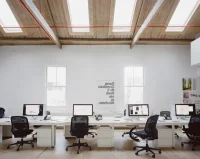The Company You Keep is a design practice working on commissioned and self-directed studies between luxury, hospitality and the arts. Grounded in the position that design renders meaning into experience, typologies err to the experiential, spanning strategy, brand, installation, print, placemaking and digital. Precedent is drawn outside of categorical standards to form work that is both novel and distinct. Fundamental to our practice is a curatorial approach; instep with artists, makers and creators, that places brands in direct conversation with culture.
Please direct all commission enquiries to Penny Gow, penny@tcyk.com.au, +61 426 899 956
Current
MFW
26
At Melbourne Food & Wine Festival 2026, Iain Hewitson together with Bistra and TCYK will revive his seminal Collingwood restaurant Clichy (1977–1982).
NCP
12
Consultation, identity design and wayfinding for a new contemporary art museum with architecture by Kerstin Thompson Architects.
ZBT
03
Collaborative artwork and research practice with Brud Studia. Exploring the themes and typographic forms of Polish art periodical Zwrotnica (1922—1927). Exhibition early 2026.
Commissions
Self-Directed
Services
Brand Identity
Strategy & Positioning
Naming
Identity Design
Bespoke Typography
Tone of Voice
Copywriting
Campaign & Marketing
Website
Packaging
Publication
Creative Direction
Art Curation
Art Direction (Stills & Motion)
Consultation
Placemaking
Strategy
Wayfinding
Signage
Cultural Programming
Activations
Brand Identity
Strategy & Positioning
Naming
Identity Design
Bespoke Typography
Tone of Voice
Copywriting
Campaign & Marketing
Website
Packaging
Publication
Creative Direction
Art Curation
Art Direction (Stills & Motion)
Consultation
Placemaking
Strategy
Wayfinding
Signage
Cultural Programming
Activations
Select Clients
1301SW
Arc'teryx
Architecture Media
Aventuur
BLEED Festival
Bistra
Broadsheet Media
Centre for Contemporary Photography (CCP)
City of Melbourne
Contemporary Arts Precincts
Country Road Group
Dance Massive
Decus Interiors
Fashion Journal
Fini Group
Jardan
Jackalope Group
July
La Trobe University
Lavazza
Louis Vuitton Moët Hennessey (LVMH)
Love Tea
Maddox
Marriott Hotels
Monash University, Art, Design & Architecture (MADA)
Morris Group
National Centre for Photography (NCP)
National Gallery of Victoria (NGV)
Pana Organic
Paramount House Hotel
Powell & Glenn Architects
PriceWaterhouseCoopers (PWC)
Raes
Royal Melbourne Institute of Technology (RMIT)
St. Ali
Samu
Tait
The Equality Institute
Up There Store
Viktoria & Woods
Witchery
1301SW
Arc'teryx
Architecture Media
Aventuur
BLEED Festival
Bistra
Broadsheet Media
Centre for Contemporary Photography (CCP)
City of Melbourne
Contemporary Arts Precincts
Country Road Group
Dance Massive
Decus Interiors
Fashion Journal
Fini Group
Jardan
Jackalope Group
July
La Trobe University
Lavazza
Louis Vuitton Moët Hennessey (LVMH)
Love Tea
Maddox
Marriott Hotels
Monash University, (MADA)
Morris Group
National Centre for Photography (NCP)
National Gallery of Victoria (NGV)
Pana Organic
Paramount House Hotel
Powell & Glenn Architects
PriceWaterhouseCoopers (PWC)
Raes
Royal Melbourne Institute of Technology (RMIT)
St. Ali
Samu
Tait
The Equality Institute
Up There Store
Viktoria & Woods
Witchery
Team
A collective of designers, strategists, art directors, curators, writers and makers. Presently: Alexandra Woolf, Claire Bradbury, Conor McCabe, Corey James, Ella Fajdiga, Erin Callaghan, Jodie Dean, Joëlle Thomas, Jordan Dolheguy, Luke Brown, Penny Gow, Rhys Gorgol, Sophie Jedlin and Tashi van der Waerden.
A collective of designers, strategists, art directors, curators, writers and makers. Presently: Alexandra Woolf, Claire Bradbury, Conor McCabe, Corey James, Ella Fajdiga, Erin Callaghan, Jodie Dean, Joëlle Thomas, Jordan Dolheguy, Luke Brown, Penny Gow, Rhys Gorgol, Sophie Jedlin and Tashi van der Waerden.
Contact
For new business enquiries, penny@tcyk.com.au, +61 426 899 956
For general enquiries, enquiries@tcyk.com.au, +61 3 8578 3548
For all employment enquiries please refer to our employment page
Sign up to The Company You Keep newsletter
For new business enquiries
penny@tcyk.com.au
61 426 899 956
For general enquiries
enquiries@tcyk.com.au
+61 3 8578 3548
For all employment enquiries please refer to our employment page
Sign up to our newsletter

